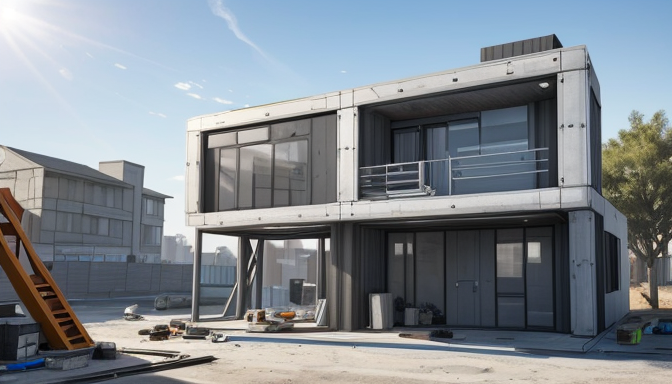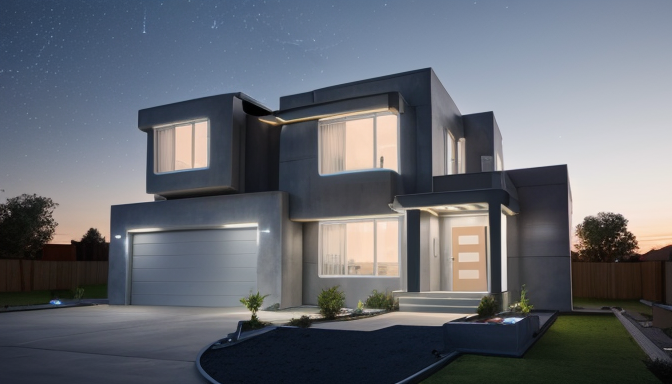Imagine a world where homes can be constructed in a matter of hours instead of months. 3D printing technology is making this dream a reality, revolutionizing the construction industry with its incredible speed and efficiency. But how does it actually work? At its core, 3D printing, or additive manufacturing, involves layering materials to create a structure from a digital model. This process can utilize a variety of materials, including concrete, plastics, and even recycled substances, to build robust homes quickly.
The magic happens when a large printer, often resembling a robotic arm, extrudes the chosen material layer by layer, following the blueprint of the house. As each layer dries or sets, it becomes part of the solid structure, allowing for rapid assembly. This method not only speeds up the construction process but also minimizes waste, making it an eco-friendly alternative to traditional building methods. Think of it like icing a cake—each layer adds to the final product, creating something beautiful and functional.
One of the most exciting aspects of 3D printing in construction is its ability to customize designs. Homebuyers can tailor their future homes to fit their unique needs and preferences without the exorbitant costs usually associated with custom builds. Imagine being able to tweak the layout of your living room or the size of your windows with just a few clicks! This level of personalization is a game-changer in an industry that often feels rigid and unyielding.
However, while the benefits are compelling, the technology is still in its infancy. As we explore the journey of 3D printing in construction, we must also consider the challenges it faces. From regulatory issues to public perception, the path to widespread adoption is filled with hurdles. But if the potential of this technology is realized, we could see a future where affordable housing is accessible to everyone.
The Technology Behind 3D Printing
3D printing, also known as additive manufacturing, is revolutionizing the construction industry by offering a fast and efficient way to build homes. But how does it actually work? At its core, 3D printing involves creating three-dimensional objects from a digital file. This process begins with a 3D model, which can be designed using computer-aided design (CAD) software. The model is then sliced into thin horizontal layers, which the printer will use as a guide to build the structure layer by layer.
The primary materials used in 3D printing for construction include concrete, plastics, and even metallic composites. The most common method employed is the extrusion technique, where a nozzle dispenses the material through a computer-controlled system. This method allows for precise control over the placement of the material, ensuring that each layer bonds effectively with the one below it. Some advanced printers can even incorporate reinforcements like steel rods or fibers to enhance the structural integrity of the building.
One of the standout features of 3D printing technology is its ability to create complex designs that traditional construction methods struggle with. Imagine being able to construct a house with intricate shapes and features that would otherwise be cost-prohibitive or time-consuming to achieve. This capability not only paves the way for more creative designs but also allows for significant customization based on individual needs and preferences.
However, while the technology is promising, it is essential to understand the limitations and challenges that come with it. For example, the speed of printing can vary based on the size and complexity of the design. Additionally, the materials used must meet specific building codes and regulations, which can complicate the process. As the technology continues to evolve, we can expect to see more innovations that will address these challenges and push the boundaries of what’s possible in construction.

Benefits of 3D Printed Houses
When it comes to revolutionizing the construction industry, 3D printed houses are leading the charge. Imagine a world where homes can be built in a fraction of the time it traditionally takes. This isn’t just a futuristic dream; it’s a reality that is reshaping urban landscapes. One of the most significant benefits of this innovative technology is its cost-effectiveness. By utilizing materials more efficiently and reducing labor costs, 3D printing can lower the overall expenses associated with home construction.
Moreover, 3D printing drastically reduces waste. Traditional construction methods often lead to excess materials being discarded, but with 3D printing, every ounce of material is used purposefully. This not only helps the environment but also makes the entire process more sustainable. Picture this: a construction site with minimal debris, where every component is crafted to perfection. It’s like a perfectly choreographed dance, where every move counts!
Another compelling advantage is the speed at which these homes can be constructed. While conventional building methods can take months or even years, 3D printed houses can be erected in just a few days. This rapid turnaround is particularly beneficial in areas facing housing shortages or natural disasters. In fact, some projects have reported completion times as short as 24 hours! Imagine the relief for families who can move into their new homes almost overnight.
Additionally, the customization potential is immense. Homebuyers can personalize their designs without the hefty price tag that usually accompanies custom builds. Whether it’s an open floor plan or unique architectural features, 3D printing allows for a level of flexibility that traditional methods simply can’t match. It’s like having a tailor for your house, crafting a living space that’s uniquely yours.
In summary, the benefits of 3D printed houses are not just about speed and cost; they encompass sustainability, customization, and efficiency. As this technology continues to evolve, it holds the promise of transforming how we think about housing in the future.
Challenges Facing 3D Printing in Construction
While the concept of 3D printing in construction sounds revolutionary and full of promise, it’s not without its hurdles. One of the primary challenges is navigating the complex landscape of regulatory hurdles. Governments and local authorities often have strict building codes and regulations that can stifle innovation. Imagine trying to fit a square peg into a round hole; that’s what it feels like when trying to get approval for a 3D-printed home. The lack of standardized regulations means that projects can face delays and additional costs, making it a daunting task for builders.
Another significant challenge is the limitations of materials. While various materials can be used in 3D printing, not all are suitable for construction. Most commonly, concrete is used, but it has limitations in terms of structural integrity and weather resistance. This leads to a crucial question: how do we ensure that these homes are not only quick to build but also durable and safe? The answer lies in ongoing research and development, but until then, the industry is left grappling with material constraints.
Furthermore, there’s the issue of public perception. Many people are still skeptical about living in a 3D-printed house. They may associate it with low quality or temporary structures. This perception can hinder acceptance and adoption. To combat this, education and transparency about the technology’s benefits are essential. We need to paint a clear picture of how 3D printing can lead to affordable housing solutions without compromising quality.
In summary, while 3D printing in construction holds incredible potential, it faces significant challenges that must be addressed. Overcoming these obstacles will require collaboration among industry stakeholders, innovative thinking, and a willingness to adapt to new technologies.

Real-World Applications and Case Studies
As the world grapples with housing shortages and escalating construction costs, 3D printing technology has emerged as a beacon of hope. This innovative approach is not just a futuristic concept; it’s already being put into practice in various parts of the globe. For instance, in 2018, ICON, a construction technologies company based in Austin, Texas, unveiled the first permitted 3D-printed home in the U.S. This project, known as the Vulcan II, showcased how a house could be printed in less than 24 hours, utilizing a special concrete mix that is both durable and cost-effective.
Another remarkable example can be found in Mexico, where a non-profit organization called New Story partnered with ICON to create an entire neighborhood of 3D-printed homes. In this project, they successfully built ten homes in just a few weeks, demonstrating not only the speed of construction but also the potential for affordable housing solutions in underserved communities. The homes were designed to withstand the local climate and were tailored to meet the needs of the residents, showcasing the customization capabilities of 3D printing.
Furthermore, in Europe, a project in the Netherlands called Project Milestone is pushing the boundaries of 3D printing in construction. This initiative aims to construct a series of 3D-printed houses that will eventually form a complete neighborhood. The project emphasizes sustainability, using eco-friendly materials and energy-efficient designs to create homes that are not only affordable but also environmentally responsible.
These case studies highlight the transformative potential of 3D printing in the housing sector. By addressing key challenges such as speed, cost, and customization, 3D-printed homes are paving the way for a new era in construction. As we look to the future, the implications of these innovations could be profound, potentially reshaping urban landscapes and providing shelter to millions in need.
The Future of 3D Printed Housing
The future of 3D printed housing is nothing short of exciting! Imagine a world where homes can be erected in a matter of days, not months. With the rapid advancements in 3D printing technology, this dream is becoming a reality. As more companies invest in this innovative construction method, we can expect a revolution in how we think about building homes. But what does this mean for the housing market and society as a whole?
One of the most significant implications of 3D printed housing is its potential to address the global housing crisis. With millions of people lacking adequate shelter, the ability to produce affordable homes quickly could change lives. For instance, projects like ICON and Apis Cor have already demonstrated how entire neighborhoods can be built using 3D printing, providing essential housing in disaster-stricken areas.
Moreover, the environmental impact of traditional construction is substantial. 3D printing offers a more sustainable alternative by minimizing waste and utilizing eco-friendly materials. As we move towards a greener future, the construction industry must adapt, and 3D printing could be the key to achieving this goal. Imagine a world where homes are not only affordable but also built from recycled materials!
However, challenges remain. Regulatory frameworks are still catching up with this technology, and public perception can be slow to change. Many people are still skeptical about living in 3D-printed homes. To overcome these hurdles, education and outreach will be crucial. As more success stories emerge, the stigma surrounding this innovative approach will likely diminish.
In conclusion, the future of 3D printed housing is bright, filled with possibilities that could reshape our urban landscapes. As technology continues to evolve, we may find ourselves living in homes that are not only affordable and sustainable but also uniquely tailored to our needs. The question remains: are we ready to embrace this change?
Frequently Asked Questions
- What is 3D printing in construction?
3D printing in construction refers to the innovative process of using additive manufacturing technology to create building structures layer by layer. This method significantly speeds up the construction process and allows for unique designs that traditional methods may struggle to achieve.
- How long does it take to build a house using 3D printing?
In many cases, a 3D printed house can be constructed in just 24 hours! This rapid build time is one of the standout benefits of the technology, making it a game-changer for addressing housing shortages.
- Are 3D printed houses durable?
Absolutely! 3D printed houses are made using durable materials like concrete, which can withstand various environmental challenges. The technology ensures that the structures meet safety standards and can provide long-lasting homes.
- What are the cost benefits of 3D printed houses?
3D printing can significantly reduce construction costs by minimizing labor expenses and material waste. This efficiency means that homeowners can save money while still getting a high-quality living space.
- What challenges does 3D printing face in construction?
While 3D printing is promising, it faces challenges such as regulatory hurdles, public perception issues, and limitations in material types. Overcoming these obstacles is essential for wider adoption in the construction industry.

